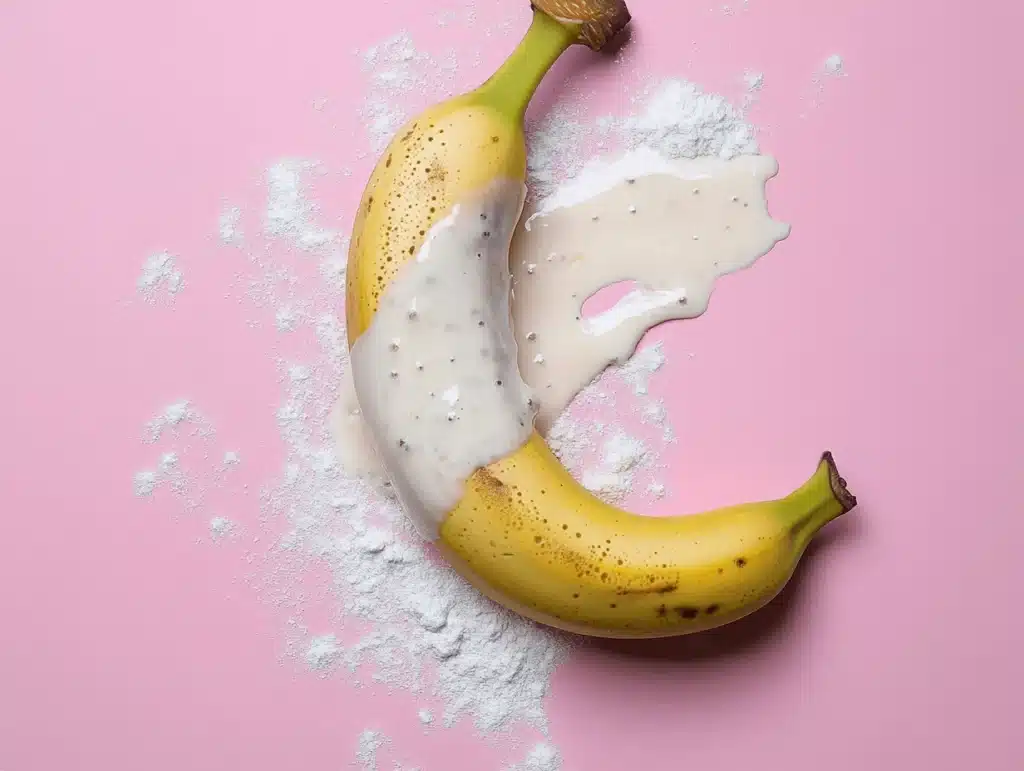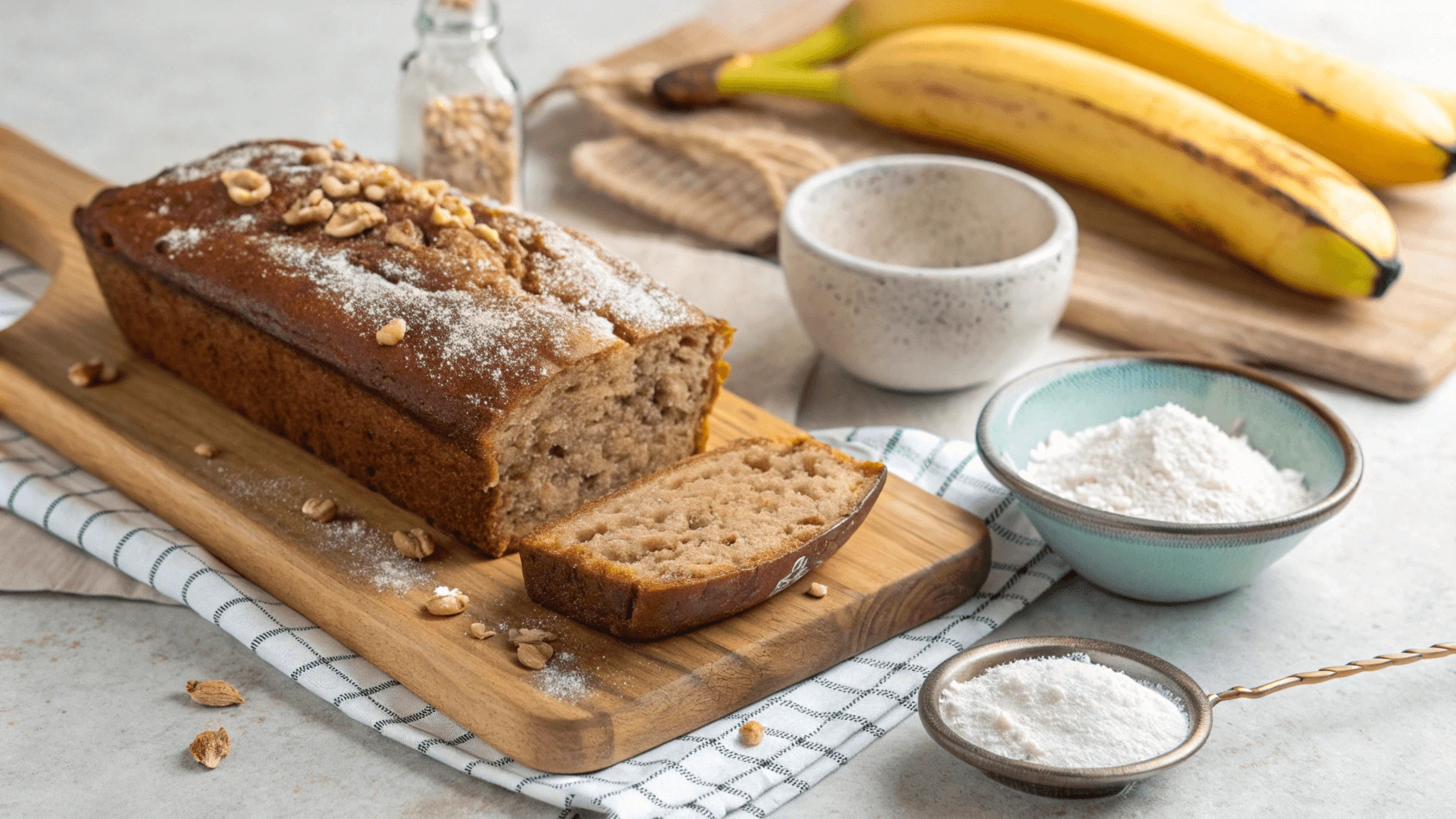Have you ever wondered if too much baking soda can ruin your banana bread? This essential ingredient helps your bread rise and achieve the perfect texture, but overuse can lead to bitter flavors and a dense, unappealing loaf. In this article, we’ll explore the effects of baking soda and share tips to bake the perfect banana bread every time.
What Is Baking Soda and Why Does It Matter in Banana Bread?
Baking soda is a leavening agent, which helps your banana bread rise as it bakes. However, using too much can result in an unpleasant taste and texture. Here’s why:
- Leavening effect: It reacts with the acidity in the banana mixture, releasing carbon dioxide, which causes the bread to rise.
- Taste balance: While it aids in rising, too much baking soda can overpower the other flavors in your banana bread.
- Texture: It also influences the texture. If used excessively, it can create a crumbly, dry loaf.
So, it’s important to find the right balance when using baking soda.
The Role of Baking Soda in Banana Bread
Baking soda’s primary function in banana bread is to help it rise. When combined with acidic ingredients such as mashed bananas, it creates a reaction that produces bubbles of carbon dioxide gas. This process is vital to making the bread fluffy and light. But, how much baking soda is too much?
When you add too much baking soda, it can lead to an overreaction, causing the bread to rise too quickly and then collapse. This could result in a dense and heavy loaf. Additionally, excessive baking soda can leave behind an aftertaste, which is not desirable in banana bread.
How Does Too Much Baking Soda Affect the Taste?
One of the most significant concerns with using too much baking soda is its impact on the flavor of your banana bread. Baking soda has an alkaline taste, which can be noticeable if too much is used. This off-flavor can overpower the sweetness of the bananas, making your banana bread taste strange or bitter.
Here’s a simple guide to the effects of too much baking soda on flavor:
- Slightly too much: May leave a mild, unpleasant aftertaste.
- Significantly too much: The entire loaf may have a strong metallic flavor.
- Perfect amount: A subtle flavor that enhances the bread’s natural sweetness.
Will Too Much Baking Soda Ruin Banana Bread?
Yes, using too much baking soda can ruin your banana bread. It’s crucial to follow a recipe closely to avoid this common mistake. Typically, you need just 1 teaspoon of baking soda for every 1 to 2 cups of mashed bananas. If you use more than that, it may negatively affect the taste and texture.

To prevent ruining your banana bread, it’s a good idea to:
- Measure ingredients carefully
- Stick to the recommended amount of baking soda
- Check the rise and texture during baking
By adhering to these tips, you can ensure a perfect loaf every time.
How Much Baking Soda Is Too Much?
Determining how much baking soda to use in banana bread is essential for achieving the perfect rise and flavor. The general rule of thumb is that for every cup of flour, you should use about 1/4 to 1/2 teaspoon of baking soda. However, for banana bread, the ripe bananas often provide enough acid to activate the baking soda.
- More than 1 teaspoon per 2 cups of flour: May result in too much rising, leading to a crumbly texture.
- Less than the recommended amount: May cause the bread to be dense or fail to rise properly.
Therefore, sticking to the suggested amount in your recipe is important for consistent results.
How to Fix Banana Bread if You’ve Used Too Much Baking Soda
Accidents happen, and sometimes you might add a little too much baking soda. However, there are ways to salvage your banana bread:
- Taste test the batter: If the batter tastes too alkaline, try to adjust by adding a little extra sugar or vanilla extract to balance the flavor.
- Check the texture: If the texture is too crumbly or dry, you may want to add some extra moisture, such as milk or oil.
- Make a new batch: If the bread is beyond repair, it might be best to start fresh, but be sure to stick to the correct baking soda measurement.
Common Mistakes When Using Baking Soda in Banana Bread
There are a few mistakes people often make when using baking soda in banana bread. By avoiding these, you can ensure better results every time:
- Using too much baking soda: This is the most common mistake and the one that leads to ruined banana bread.
- Not measuring the ingredients: Baking is a science, so precision is key.
- Not letting the batter rest: After mixing, let the batter sit for 5-10 minutes. This gives the baking soda time to react with the bananas.
- Using old baking soda: If your baking soda is too old, it may not react effectively with the ingredients, affecting the rise.
Signs Your Banana Bread Has Too Much Baking Soda
There are some obvious signs that your banana bread may have too much baking soda:
- Flat or dense texture: The bread doesn’t rise well, and the crumb may feel heavy or rubbery.
- Unpleasant taste: A strong, bitter aftertaste is a clear indicator of excess baking soda.
- Odd coloring: Overuse of baking soda can lead to a strange color, often making the bread appear too dark on the outside.
The Best Way to Ensure Perfect Banana Bread Every Time
To ensure your banana bread comes out perfectly every time, consider these tips:
- Follow the recipe precisely: Always use the specified amount of baking soda.
- Use fresh ingredients: Fresh bananas and baking soda ensure the best results.
- Measure carefully: A kitchen scale can be your best friend in ensuring accurate measurements.
- Experiment with add-ins: Try adding walnuts or pecans for extra flavor and texture.
By sticking to these best practices, you’ll avoid the issue of too much baking soda and enjoy delicious, fluffy banana bread.
FAQs: Common Questions About Baking Soda and Banana Bread
Can You Put Too Much Baking Soda in Banana Bread?
Yes, you can put too much baking soda in banana bread, and doing so can negatively affect both the taste and texture. When you use too much baking soda, the bread may develop an unpleasant, bitter or metallic taste. Additionally, it can cause the bread to rise too quickly and then collapse, leading to a dense or crumbly texture. It’s important to stick to the recommended amount, typically about 1 teaspoon per 1 to 2 cups of mashed bananas.
What Happens When You Bake with Too Much Baking Soda?
Baking with too much baking soda can lead to a number of problems in your banana bread. Firstly, it may cause the bread to rise excessively and then sink, resulting in a flat loaf with an unappealing texture. Moreover, the excessive amount of baking soda can create a soapy or metallic taste that overpowers the natural flavors of the bananas. To avoid these issues, it’s crucial to measure baking soda carefully and stick to the recommended amount for the recipe.
How to Fix Too Much Baking Soda in Bread?
If you accidentally use too much baking soda in your banana bread, there are a few ways to try fixing it:
- Adjust the flavor: If the batter tastes too alkaline, you can balance it by adding a little extra sugar or vanilla extract.
- Increase moisture: If the bread turns out too dry or crumbly, consider adding extra moisture in the form of milk, yogurt, or oil.
- Make a new batch: If the bread is beyond repair, it’s often best to start fresh and use the correct measurements of baking soda.
What Would Happen If You Used Too Much or Too Little Baking Powder?
Baking powder is another leavening agent, and like baking soda, it’s important to use the correct amount. Using too much baking powder can result in a bitter taste, similar to baking soda. It can also cause the bread to rise too much, creating a crumbly or dry texture. On the other hand, using too little baking powder can lead to a dense loaf that doesn’t rise properly. Always follow the recipe guidelines for the correct amount of baking powder for best results.
Why Is My Banana Bread Not Moist?
If your banana bread isn’t moist, several factors could be contributing:
- Overmixing the batter: Overmixing can cause the bread to become dense and dry. Mix just until the ingredients are combined.
- Not enough moisture: Ensure that you’re using enough liquid, such as mashed bananas, eggs, or oil. Lack of moisture can make the bread dry.
- Baking too long: If you bake the bread for too long, it may dry out. Always check for doneness with a toothpick and remove the bread when it’s cooked through but still moist.
Why Isn’t My Banana Bread Rising?
There are several possible reasons why your banana bread isn’t rising:
- Old or expired leavening agents: If your baking soda or baking powder is too old, it won’t produce the necessary reaction to help the bread rise. Always check expiration dates.
- Too much moisture: Excess moisture can weigh down the batter, preventing the bread from rising properly. Be careful not to overdo the liquid ingredients.
- Incorrect oven temperature: If the oven is too cold, the bread may not rise properly. Preheat the oven before baking, and use an oven thermometer to ensure the correct temperature.
Conclusion: Balance Is Key for Perfect Banana Bread
In conclusion, the amount of baking soda you use in banana bread is crucial. Too much can ruin the flavor and texture, while the right amount ensures a light, fluffy loaf. Remember, the key to perfect banana bread lies in balance. Stick to the recommended amount, measure carefully, and taste-test your batter. By following these guidelines, you can enjoy banana bread that is both flavorful and perfectly textured, every time.

